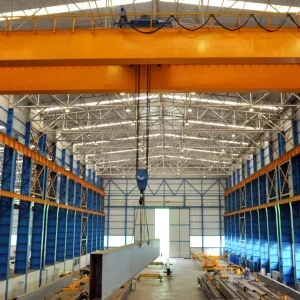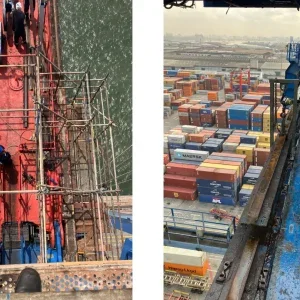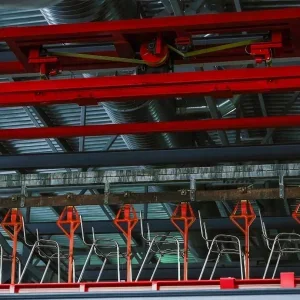Construction materials and industrial ceramics giant Saint Gobain commissioned the world’s newest glass production plant at Egborough, Yorkshire in April. Measuring nearly 1km long, the fully integrated plant in the north of England was built in just 16 months at a cost of £80m ($130m). The plant features sophisticated cranes that are used in critical process and maintenance operations.
Strategic objective
Saint Gobain, whose products are distributed through its own Solaglas chain and independent glass wholesalers, has about 25% of the UK glass market. Until now, it has imported glass into the UK from the European mainland. To secure a larger market share the company needed a high volume glass factory in the UK to produce flat glass for the construction industry and house builders.
The first earth was broken at Egborough in November 1998, but the project had already been 30 months in design and planning. The facility combines receipt and processing of raw materials, flat glass production, cutting, warehousing, packing and shipment under one roof. On a continuous basis the plant will produce between 600t and 650t of glass per day for the next 12 years with only partial closures, phased for periodic maintenance.
Exacting demands
The demands placed on cranes in this environment are high. A package of 10 advanced cranes and hoists was supplied by Street Crane under a £530,000 ($850,000) contract. These will be used for process and maintenance.
In the main production and warehouse area there are five 16t double girder cranes spanning the 24m bays. Because of the high number of crane movements and the continuous operation, total reliability was essential, therefore all mechanisms are rated M7.
The M7 classification was agreed with Saint Gobain after undertaking several ‘what if?’ calculation cycles on Street’s bespoke SC Compucrane design software. This models real life use and allows the effects of changes in work pattern to be assessed easily. Under-specified equipment would meet short term needs, but it would have failed eventually, requiring more maintenance – problems that are not desirable in a continuous process operation.
To ensure precise movement with careful product placement, these cranes use SC Smartdrive inverter control on all motions. This contributes to greater safety by controlling the acceleration and deceleration of the heavy packs of glass so that stability is assured at all times. Final manoeuvring speeds are only a fraction of the maximum for ultimate control over glass placement.
These large cranes handle 12t glass packs which are delivered by electric truck from the production area into the warehouse. Special glass handling devices, supplied by Teodoro Impianti of Italy, are installed on three of the cranes. This component was specified by Saint Gobain and is the same as those used at other Saint Gobain plants across Europe.
Operators need to work the cranes from a position of safety and good visibility. For this reason Saint Gobain requested radio remote control. The omission of conventional pendants gives greater freedom of movement and the radio sets are deemed to be inherently more reliable and easy to exchange if trouble develops.
Control of all crane motions and grab movements is from the radio device. This makes it possible for the cranes with the Teodoro Impianti grabs to lift and rotate the glass pack for location within storage racks and subsequently to retrieve and rotate the pack to place it on the delivery vehicle. The feet and arms of the grab are controlled from the radio which controls the permitted combinations of feet and arms to ensure safe handling and manipulation of the heavy glass packs.
Because flexibility is important in production operations, a single 6t double girder, dual speed crane has been provided in the production area. This enables smaller glass packs to be handled efficiently.
Efficient plant maintenance
Elsewhere in the plant there are other Street cranes and hoists. Two Street NX 3.5t hoists are installed in the furnace area and an additional 5t maintenance crane is provided in the float glass area. These maintenance cranes have a critical role in ensuring efficient plant operation. They enable large sections of refractory or heavy plant items such as motors to be removed and replaced quickly. In this way, downtime on the section of plant under maintenance is minimised and full capacity is restored as soon as possible.
Cranes are not used exclusively in the plant. Large capacity forklifts are in use in some areas, but even these get overhead crane support. Power packs on the forklifts need changing from time to time, so a 4t EOT crane is provided in the battery charging area for battery transfer.
Glass industry experience
The Saint Gobain plant at Egborough is not Street’s first experience in the UK glass industry. Its cranes are also used in other major plants, most notably in Pilkington’s factory in St Helens, Merseyside. It is also a major supplier to the downstream distribution network; many Saint Gobain Solaglas depots and independents have Street cranes. According to Street, characteristics such as true vertical lift, close tolerance speed control and the availability of special vacuum handling devices make its cranes suitable for safely picking, moving and placing large glass panels with precision.






